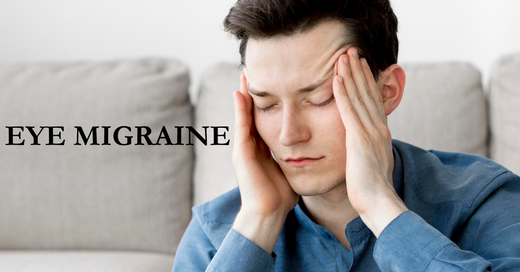
Conquering Eye Migraines: A Comprehensive Guide To Understanding Causes And Symptoms
Share
q
Table of Contents
Does Migraine Causes Eye Pain?

It is true that migraines can produce eye pain, and there are a few common reasons for this. Migraines can cause eye pain due to nerve activation, tension and muscle strain, visual disturbances, and increased sensitivity to light. These symptoms can aggravate the discomfort around the eyes and can be exacerbated by photophobia, a heightened sensitivity to light. Let’s look at some common types.
- Migraine Visual Aura
- Ocular Migraine
An ocular migraine is a rare type of migraine that leads to visual symptoms in one eye, stemming from the brain's processing of visual signals rather than an issue with the eyes themselves. If symptoms persist with eyes closed, it indicates the source is likely neurological. Though ocular migraine originally referred to any kind of migraine with visual symptoms, the terms ocular migraine and retinal migraine are often used interchangeably. Some physicians prefer the more recent term retinal migraine, which specifically refers to migraines involving visual symptoms in only one eye.
Ocular migraines and migraine visual aura can cause similar symptoms like flashing lights and blind spots, but they differ in that visual disturbances in migraine aura typically affect both eyes, while ocular migraines usually affect only one eye.
Eye Migraine Symptoms
The majority of the time, ocular migraines begin with blurred vision in one eye and last for five to sixty minutes. The symptoms can include spots of reduced or absent vision (scotomas), flashes of light, lines floating float, and zigzag patterns. These visual expressions could get more intense over time. The visual symptoms may be accompanied by a headache, which may appear suddenly or gradually and last for four to seventy-two hours if left untreated.
Ocular migraines can present with a variety of symptoms. The following are some common ones:
- Visual disturbances: These could be blind areas in one eye, zigzag patterns, or flashing lights.
- Headache Though it does not always accompany the visual symptoms, headaches typically do.
- Brief Vision Loss: A temporary loss of vision in one eye may occur to some people.
- Sensitivity to Light: Too much brightness may make you feel hurt or uncomfortable.
- Nausea: In certain situations, this may come on top of the headache.
- Dizziness: You may have unsteadiness or dizziness.
Causes of Migraine
Ocular migraines are caused by blood vessel spasms, pressure on neurones, and possibly genetics. They are more common in White individuals as opposed to Black and Asian ancestry, and they are more common in women and those assigned female at birth (AFAB) than in men and those assigned male at birth (AMAB). Migraine triggers include stress, high blood pressure, heat, smoking, alcohol, caffeine, birth control pills, dehydration, and low blood sugar. It is important to talk to a doctor about symptoms and seek medical help if the migraine persists.
Left Eye Migraine Causes
There are several things that can cause migraines in the left eye, such as:
- Vascular Changes: Alterations in blood flow, with blood vessels in the brain constricting and dilating, can impact the eye area.
- Nerve Irritation: The trigeminal nerve, which is involved in headache pathways, can become irritated or dysfunctional, leading to pain around the eye.
- Visual Aura: Some individuals may experience visual disturbances, such as flickering lights or blind spots, before the headache phase, often affecting one eye.
- Hormonal Changes: Fluctuations in hormones, particularly in women during menstrual cycles, pregnancy, or menopause, can also trigger migraines.
Right Eye Migraine Causes
Migraine triggers can include various dietary factors such as aged cheeses, processed meats, chocolate, and caffeine. Emotional stress and sleep disruptions, like irregular sleep patterns, can also provoke migraine. Eye strain from prolonged screen time or reading may lead to headaches, particularly on one side. Genetic predisposition and associated health issues, such as hypertension or sinusitis, can exacerbate migraine symptoms. Certain medications, including hormonal therapies and vasodilators, may trigger migraines as well. Additionally, dehydration and caffeine withdrawal can lead to migraine attacks.
Migraine Causes Eye Strain

Migraines may be exacerbated by eye strain, which can happen for a number of reasons:
- Screen Time: Digital eye strain from prolonged use of laptops, tablets, and cellphones can result in migraines.
- Improper Lighting: Dim or harsh lighting can cause eye strain, which raises the risk of migraines.
- Uncorrected Vision Problems: Conditions like astigmatism or nearsightedness can make the eyes work harder, which increases the risk of migraines.
- Exhaustion: A well-known migraine cause, general weariness can be exacerbated by tired eyes.
- Stress and Tension: Physical strain in the shoulders and neck can cause migraines as well as eye strain.
- Dehydration: Drinking insufficient water might cause migraines and eye strain.
- Environmental Factors: Smoke, dry air, and allergens can irritate and strain the eyes, which can aggravate migraine attacks.
Frequently Asked Questions
What causes eye migraine?
Eye migraines can be triggered by several factors, including reduced blood flow due to blood vessel constriction, eye strain from binocular vision issues, caffeine withdrawal, and sinusitis from allergies or infections. Other common triggers include hormonal changes, bright or flashing lights, alcohol, weather changes, skipping meals, and irregular sleep patterns.
Does migraine cause eye pain?
Migraines, especially ocular migraines, can cause pain behind one eye, accompanied by severe headaches, light sensitivity, nausea, and visual disturbances. Other types of headaches, such as tension, cluster, and sinus headaches, as well as eyestrain, can also lead to similar eye pain.
